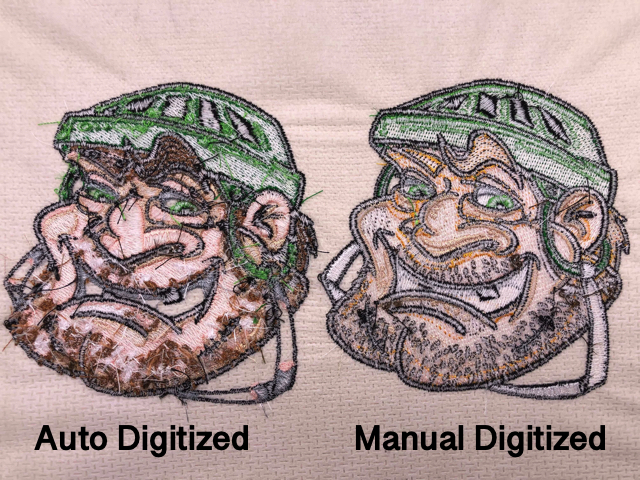Expert Digitizing for Embroidery: Rapid and Reliable Solution
Expert Digitizing for Embroidery: Rapid and Reliable Solution
Blog Article
Streamlining the Art of Embroidery Digitizing: Step-by-Step Guide
As innovation proceeds to development, the digitization procedure has come to be a lot more easily accessible, enabling lovers to bring their complex layouts to life with convenience. In this overview, we will untangle the complexities of needlework digitizing, damaging down each step methodically to streamline the process and equip both novices and experienced embroiderers alike.
Comprehending Embroidery Digitizing Software Program
Embroidery digitizing software functions as an important tool for changing detailed styles right into electronic formats compatible with embroidery devices, assisting in exact sewing and modification. This specific software application allows individuals to import various photo file layouts, such as JPG or PNG, and convert them into needlework machine-readable formats like DST, EXP, or PES - Digitizing for Embroidery. By utilizing features like stitch editing, padding alternatives, and thread shade selection, digitizing software application enables individuals to regulate every element of the style process
In addition, progressed needlework digitizing software application provides devices for producing complex styles, changing stitch density, and integrating detailed details. Individuals can also preview the style before sewing it out, ensuring accuracy and reducing mistakes. Furthermore, several software programs provide automatic features that aid streamline the digitizing process, saving time and effort.
Understanding the capacities of embroidery digitizing software application is crucial for attaining top quality lead to needlework jobs. By understanding this device, needlework lovers and professionals can release their creative thinking and bring detailed styles to life with accuracy and efficiency.

Picking the Right Design File
After familiarizing on your own with the capabilities of needlework digitizing software, the following critical action in the process is picking the right layout file for your task. Digitizing for Embroidery. When selecting a style file for needlework digitizing, it's necessary to consider the complexity of the layout, the size of the final item, and the kind of textile you will certainly be collaborating with
For complex layouts with fine information, a high-resolution photo or vector data is recommended to guarantee that the needlework machine can properly replicate the design. In addition, the size of the end product plays a substantial duty in selecting the appropriate style data. Bigger styles may require higher resolution files to preserve quality and sharpness.
Furthermore, the kind of textile you will be embroidering on influences the selection of layout file. Different materials might call for changes in the style data to ensure that the stitches are effectively aligned and the style shows up as meant. By thoroughly choosing the appropriate layout data based on these variables, you can establish yourself up for an effective needlework digitizing procedure.
Digitizing Devices and Strategies
Utilizing specialized software application and precision methods, digitizing devices are vital in changing complex designs into embroidery-ready data. Needlework digitizing software program, such as Wilcom, Hatch, or Embrilliance, provides the needed platform to convert artwork into stitch information. These programs provide functions like stitch editing and enhancing, underlay options, and text tools to guarantee the layout converts seamlessly onto fabric.
One of the key methods in digitizing is producing a clear path for the embroidery maker to comply with. This includes digitizing each aspect of the layout with precision, determining stitch types, densities, and directions. By utilizing tools like digitizing tablet computers Check This Out or software-specific page plugins, embroiderers can attain a high degree of precision in their digitized designs.
Moreover, mastering the art of rug sewing is vital for creating high quality embroidery. Underlay sewing maintains the fabric and produces a structure for the design, making sure that the final item is both visually appealing and lasting. By recognizing these digitizing devices and methods, embroiderers can raise their craft and bring intricate designs to life with accuracy and performance.
Customizing Stitch Kinds and Instructions
The option of stitch types can considerably impact the overall look and appearance of the stitched layout. By strategically integrating these stitch kinds, embroiderers can attain depth and dimension in their styles.
In addition, the instructions of stitches plays a crucial role in boosting the you can check here visual appeal of the final embroidery. Numerous stitch instructions can include texture, emphasize particular aspects, and produce aesthetic interest. For circumstances, transforming the angle of stitches can mimic motion or all-natural patterns like fur or feathers. By explore various stitch angles and patterns, embroiderers can bring their styles to life with amazing detail and ins and out. Grasping the art of personalizing stitch kinds and instructions equips embroiderers to release their creativity and raise the top quality of their work.
Testing and Refining Your Digitized Design
To ensure the accuracy and top quality of your digitized design, thorough testing and refinement are crucial steps in the embroidery digitizing procedure. Once you have completed the digitization of your style, it is crucial to evaluate it before waging the actual embroidery. Checking enables you to identify any possible problems such as string breaks, sew thickness troubles, or layout distortions that might influence the outcome.

After screening, it is essential to improve your digitized style based upon the responses from the test sew-out. This might involve tweaking stitch setups, readjusting densities, or making adjustments to the overall design to attain the preferred result. By iterating through testing and improvement, you can tweak your digitized layout to excellence prior to moving on with the real embroidery procedure.
Final Thought
In conclusion, understanding the art of needlework digitizing requires a detailed understanding of the software application, choosing the best style file, utilizing digitizing devices and techniques, customizing stitch types and directions, and testing and improving the digitized style. By adhering to these actions, embroiderers can streamline the digitizing process and create top quality stitched styles with precision and performance.
Report this page